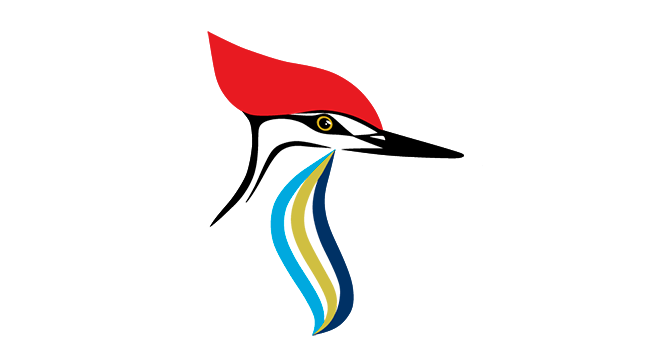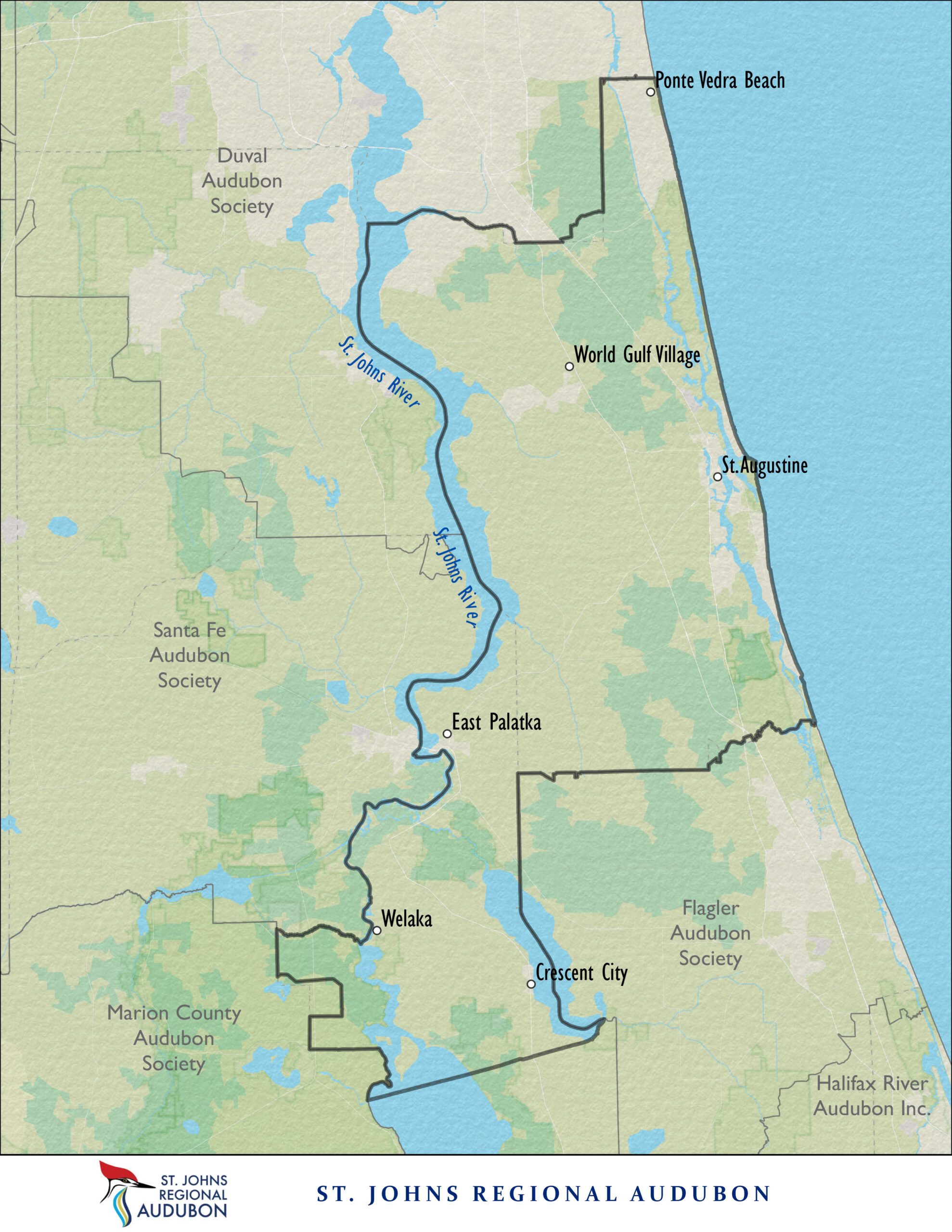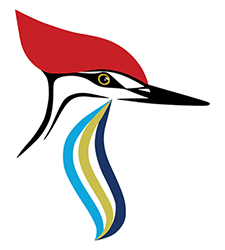
St. Johns Regional Audubon
Celebrating and protecting birds from the river to the ocean in NE Florida
Birding Hotspots Near Us
We have prepared one-page guides to over 20 of our favorite hotspots in St. Johns and eastern Putnam County (our Chapter territory) that you should be able to easily print. The guides also contain links to maps, websites, and in the case of several of the hotspots, a link to their Great Florida Birding and Wildlife Trail page.
Use the buttons below to reach the one-pager for a specific hotspot. We hope you enjoy these one-pagers! If you see any errors or have any suggestions to improve them, please email stjohnsaudubonsociety@gmail.com.

ALPINE GROVES PARK
Alpine Groves Park is a museum park. The grounds include nature trails, picnic area, a fishing pier (with breathtaking sunsets), butterfly garden, and historic structures such as an orange grove homestead. This is a popular hiking area for locals. Leashed dogs are allows with walkers.
LINK to 1-page PDF for Alpine Groves
ANASTASIA STATE PARK
Anastasia State Park comprises more than 1,600 acres of beaches, tidal marshes, maritime hammocks, and ancient sand dunes. There is an abundance of wildlife found in the various habitats. The park is part of The Great Florida Birding and Wildlife Trail.
LINK to 1-page PDF for Anastasia State Park
BIRD ISLAND PARK (at Ponte Vedra Branch Library)
Bird Island Park opened in 2010. It is the result of hard-working volunteers who made a concerted effort to provide a beautiful nature walk and park for residents. It is a beautiful replica of bird habitats as well. A stroll through the park begins at the Gazebo and then through a turtle-shaped hedge maze of native plantings. As you pass the maze, to the right is a water feature with a bird rookery and second gazebo surrounded by a boardwalk. Bird Island is a relatively small park and is wheel chair accessible.
LINK to 1-page PDF for Bird Island Park – Ponte Vedra Beach
CANOPY SHORES PARK
Canopy Shores Park is a 33 acre site located within the St. Augustine Shores Planned Unit Development (PUD) located off US 1. As the name implies, Canopy Shores Park is filled with majestic canopy oak trees defined by three distinct vegetative communities, the Hydric Hammock, Estuarine Tidal Marsh and the Floodplain Swamp.
LINK to 1-page PDF for Canopy Shores Park
Deep Creek Conservation Area
Dr. Robert Hayling Freedom Park
Riberia Point was renamed the Dr. Robert Hayling Freedom Park by the City of Saint Augustine in 2017 in honor of a key leader of the Civil Rights Movement. Seven years of efforts by concerned birders to designate the park as a site on the Great Florida Birding and Wildlife Trail were successful in August, 2023, after 160 species of birds were reported on the EBird database. This official designation by the state Fish and Wildlife Conservation Commission (FWC) was unique for a small urban park and should help shape the destiny of the park.
LINK to 1-page PDF for Dr. Robert Hayling Freedom Park
Dunns Creek State Park
Located south of a sharp bend in the St. Johns River, Dunns Creek State Park has more than 6,200 acres of natural community, including sandhills covered with longleaf pines, wiregrass, and sand pine scrub. It is home to several endangered and threatened species including the gopher tortoise, fox squirrels and other native species.
LINK to 1-page PDF for Dunns Creek State Park
FAVER-DYKES STATE PARK
Faver-Dykes State Park is a gorgeous piece of Old Florida and part of the Great Birding and Wildlife Trail. The park has a full list of activities including birding, hiking, boating, camping, fishing, and playgrounds.
LINK to 1-page PDF for Faver-Dykes State Park
FORT MATANZAS NATIONAL MONUMENT & MATANZAS INLET
Fort Matanzas was a military outpost from the Spanish Colonial days. It protected St. Augustine from invasion. Today, it is an essential part of preserving the natural lands and wildlife of the area. Matanzas Inlet is a short distance from the Fort and has parking just north of the Matanzas Inlet Bridge.
LINK to 2-page PDF for Fort Matanzas National Monument (and Matanzas Inlet)
FORT MOSE HISTORIC STATE PARK
Fort Mose is a historic park and is a critical stopping point for birds to feed and rest. It is part of The Great Florida Birding and Wildlife Trail and is has been designated as an important bird area by the National Audubon Society. The park is located along the intracoastal waterway and includes salt marsh and maritime hammock. It is an important rookery and hosts imperiled species such as Wood Storks.
LINK to 1-page PDF for Fort Mose Historic State Park
GOURD ISLAND CONSERVATION AREA
Gourd Island is a hidden gem in busy area. It is called an island because the swamp forms a gourd-shaped island.
LINK to 1-page PDF for Gourd Island Conservation Area
GUANA LAKE & RIVER
This wildlife management area is a fantastic birding spot and part of the Great Florida Birding and Wildlife Trail. It offers 15 miles of hiking trails through flatwoods, oak hammocks, scrub, freshwater wetlands and brackish marshes as well as two viewing towers.
LINK to 1-page PDF for Guana River Wildlife Management Area
GUANA-TOLOMATO-MATANZAS NERR
The GTM NERR is a northeast Florida birding hotspot. The diversity of habitats on the Guana Peninsula account for its rich variety of birdlife. The area lies in the eastern flyway, allowing for large numbers of migrating birds to be observed.
LINK to 2-page PDF for (GTM NERR) – North of Vilano
MASTERS TRACT STORMWATER TREATMENT FACILITY
In an effort to reduce high nutrient levels, specifically Nitrogen (N) and Phosphorus (P) in the Lower St. Johns River Basin and Deep Creek, the County has designed and built a system of wetlands to drain and filter stormwater runoff from agricultural and residential areas. Situated near Deep Creek Conservation Area, St. Johns County staff manage water levels in the wetland to mimic the natural wet and dry seasons. Numerous wading birds, sparrows, migrating warblers, and raptors can be seen at the wetlands.
LINK to 1-page PDF for Masters Track Stormwater Treatment Facility
NOCATEE PRESERVE
The Nocatee Preserve encompasses 2,400 acres of land with a 4-mile stretch for up to an 8 mile out and back trail walk. Donated to St. Johns County for use as a multi-use public park, the Nocatee Preserve is a conservation area of undisturbed old Florida flora and fauna. There are some boardwalk areas, but the main trail is wide and unpaved. The trail goes through to the Intracoastal Waterway.
LINK to 1-page PDF for Nocatee Preserve
Southeast Intracoastal Waterway Park
ST. AUGUSTINE ALLIGATOR FARM
The Alligator Farm is a modern zoo that focuses primarily on reptiles. There is a wading bird rookery nestled among the alligators where birds actively roost, nest, and raise their young. The wild visiting birds are attracted to the facility because the presence of the alligators keeps the nests safe from tree climbing predators. The elevated boardwalk through the rookery allows visitors to get an intimate view of these nesting birds. Photographers regularly get award winning photos at this location especially from March through June.
LINK to 1-page PDF for St. Augustine Alligator Farm Zoological Park
STOKES LANDING CONSERVATION AREA
Stokes Landing is a conservation area within the coastal basin of the Tolomato River, purchased to protect water resources, wetlands, and wildlife habitat. It is adjacent to the Guana-Tolomato-Matanzas National Estuarine Research Reserve (GTM-NERR).
LINK to 1-page PDF for Stokes Landing Conservation Area
VAILL POINT PARK
Vaill Point Park has paved loop trails (suitable for wheelchairs) leading through hardwood hammocks down to two overlooks on both the Intracoastal Waterway (ICW) and Moultrie Creek.
LINK to 1-page PDF for Vaill Point Park
Vilano Boat Ramp
Situated in the middle of a salt marsh, with mudflats, oyster bars and open water habitats, this boat ramp and parking area at the west end of the Vilano Bridge provide great viewing opportunities forshorebirds, gulls, terns and wading birds. Low tide and spring/fall migration are the best times to visit.
LINK to 1-page PDF for Vilano Boat Ramp
Welaka National Fish Hatchery
Located in one of the prettiest areas of our Chapter footprint, the Welaka National Fish Hatchery was built in 1926 and was originally operated by the State of Florida. In 1938, the Hatchery was transferred to the U.S. Fish and Wildlife Service. The Hatchery has ponds at two locations along County Road 309 and is surrounded by the Welaka State Forest.
LINK to 1-page PDF for Welaka National Fish Hatchery
Welaka State Forest
The lovely Welaka State Forest contains two springs, and approximately 4 miles of river frontage on the St. Johns River. The Forest is divided by CR 309. The forest area west of CR 309 contains 1 educational trail and two hiking trails (Mud Spring and John’s Landing). The forest trails east of CR 309 are designated as multiple use, although mainly used by equestrian riders. It is part of the Great Florida Birding and Wildlife Trail.
LINK to 1-page PDF for Welaka State Forest
